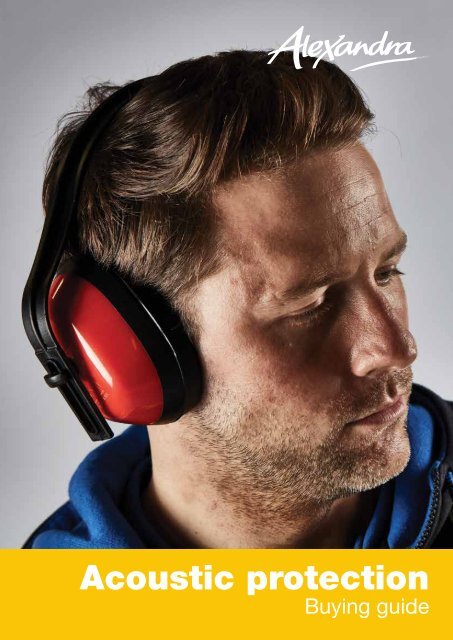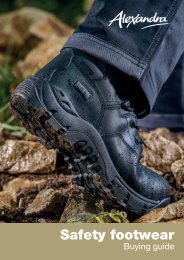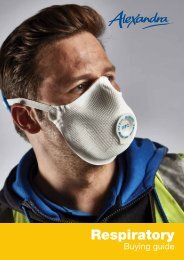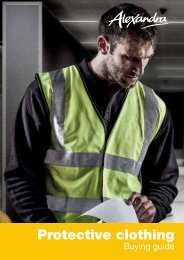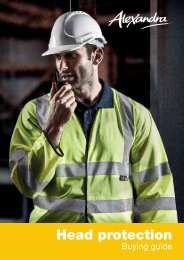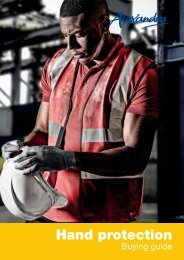Create successful ePaper yourself
Turn your PDF publications into a flip-book with our unique Google optimized e-Paper software.
<strong>Acoustic</strong> protection<br />
<strong>Buying</strong> guide
<strong>Acoustic</strong> protection<br />
<strong>Buying</strong> guide<br />
Noise levels and hearing<br />
protection explained<br />
Protecting your ears from long-term damage at work is vital. The ear can sustain damage<br />
at levels above 80dB, but it is also important to not restrict noise levels below 75dB<br />
when there is a risk of not being able to hear normal communications or warning alarms.<br />
Once you have identified the noise levels that your staff are exposed to, the purpose<br />
of ear protection is to reduce the gap between ambient workplace noise levels that are<br />
above 80dB and bring them down to a safe level. Spectacle frames and hair between<br />
the ear pad and the head may affect the performance of the ear defender. The fitting of<br />
hygiene covers to the cushions may affect the acoustic performance of the ear defender.<br />
When not in use or during transportation, ear protection unless disposable should be<br />
stored in a container that it is kept out of direct sunlight, away from chemicals and<br />
abrasive substances. Clean with warm soapy water. Solvent or abrasive cleaner should<br />
not be used.<br />
When hearing protection should be issued to employees:<br />
• Where extra protection is needed above what has been achieved using noise control.<br />
• As a short-term measure while other methods of controlling noise are being developed.<br />
You should not use hearing protection as an alternative to controlling noise by<br />
technical and organisational means.<br />
SNR rating<br />
The degree of protection offered by each product in our range is shown by the SNR<br />
(Single Number Rating) reference - so the higher the rating, the higher the level of<br />
protection. For instance, working with a chainsaw is around 100 - 110dB; to bring this<br />
down to a safe level, you would need to provide ear defenders that offer an SNR rating<br />
of around 26dB.<br />
For further guidance, please visit www.hse.gov.uk<br />
Decibel guide<br />
Busy street<br />
Telephone<br />
dial tone<br />
Busy city traffic<br />
Jack hammer<br />
Chainsaw<br />
Jet plane at 150m<br />
Human threshold<br />
of pain<br />
Shotgun<br />
Types of<br />
ear protection<br />
• Ear defenders - Sometimes known<br />
as ear muffs, ear defenders protect the<br />
wearer from extreme noises.<br />
These are cups lined with a sounddeadening<br />
material, usually acoustic<br />
foam - this absorbs sound waves by<br />
increasing air resistance, reducing the<br />
amplitude of the waves and giving<br />
protection from ambient noise.<br />
• Ear plugs - A device that is inserted<br />
into the ear canal to protect the wearer’s<br />
ears from loud noises or intrusion of<br />
water, foreign bodies, and excessive dust<br />
or wind.<br />
These can be self-adjusting, allowing<br />
the ear plugs to mould themselves to<br />
the wearer. They also come in a variety<br />
of materials for comfort and levels of<br />
protection.<br />
We offer a range of ear<br />
protection made to industry<br />
safety standards.<br />
These include:<br />
• Corded ear plugs<br />
• Banded ear plugs<br />
• Ear defenders<br />
• Ear muffs<br />
• Dispensers<br />
75 80 85 100 120 130 140 160<br />
<strong>Alexandra</strong> West Park House Midland Way Thornbury Bristol BS35 2NT<br />
t 0333 600 1111 f 0333 700 2222<br />
alexandra.co.uk


